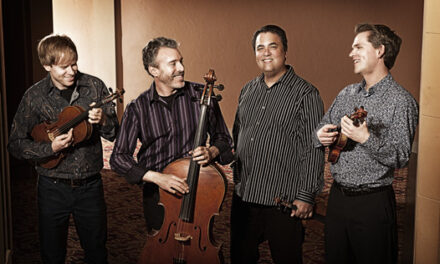Conductor Randolph Foy has made the Raleigh Civic Chamber Orchestra (and the larger Civic Symphony from which it is drawn) a model of its type. The orchestra combines students from NC State University and the Raleigh community into a performance group which educates and entertains both players and audience.
Foy puts together some of the best thematic concerts around. He thoughtfully considers how pieces can inform each other and he seeks out lesser-known but rewarding works, especially those from the twentieth century. His program notes are always exemplary, including background on the composers (and even pictures of them), recommended readings, discographies and explanations of the styles.
All Foy’s qualities were present in the concert given by the Chamber Orchestra on November 15, 2001 in the Talley Student Center Ballroom on the NCSU campus. For the themed program, “Pattern-Pulse, Baroque-Postmodern,” Foy selected pieces to show the similarities between the late Baroque and the early period of the so-called “Minimalists.” Both styles rely on continuous rhythms and repeated patterns while de-emphasizing emotion and drama.
The Baroque examples consisted of the Overture in C from Orchestra Suite no. 1 (BWV 1066) by J. S. Bach, Symphony no. 1 in Bb by William Boyce, and the Worchester Overture by the same composer. In all of these, Foy showed an experienced understanding of the period requirements: crisp rhythms, perky tempos for the grander fast movements, stately character for the slower movements, and subtle dynamic changes. Foy conducted from the harpsichord for all three, the tinkling underpinning adding a delightful charm.
These pieces are all about precision, especially considering the small number of players required, so some ragged edges were to be expected. The Bach got off to a labored start and the Worchester Overture was muggy and lost momentum. In the slower sections of all three works, the strings were sometimes thin and tentative. Generally the players were happier in the up-tempo sections, especially the bouncy middle section of the Bach and the toe-tapping dance of the Symphony’s last movement. The woodwinds were strong throughout.
The modern pieces were, frankly, much more interesting and definitely better played. The musicians seemed to respond to these works with more enthusiasm and focus, and with good reason, for the three selections were dramatic proof that modern music does not have to be off-putting and coldly academic.
First was “Company,” a suite of four short movements for string orchestra by Philip Glass, written in 1984 to accompany a dramatic adaptation of Samuel Beckett’s novel of the same name. The piece is prime Glass, with its mesmeric repetitions and pumping rhythms. . In the slower first and third movements the strings lost tonal purity, but in the faster second and fourth movements, they achieved admirable flow and cohesion in the cascading phrases. The cellos were impressive with their sharp chords and driving pulse. Foy knew the style and made the movements float along like perpetual motion.
Much more impressive was “Fratres,” by Arvo Pärt, a 1983 work for wind octet (2 each of clarinets, horns, oboes and bassoons). This Estonian composer is strongly influenced by his Eastern Orthodox religion, manifest in this piece by its solemn, sad harmonies, ritual-like pacing, and rich sonorities. The music is a series of repeated phrases, each using a different combination of the instruments. In each repetition, some instruments act as a drone, supplying an low, unbroken constant against which the other instruments move in haunting blocks of melody. The end of each section is capped by short beats from a woodblock and drum. The players’ intensity and Foy’s confident overview of the piece’s architecture led to a most satisfying performance.
The final selection was the concert’s highlight. “In C” is often designated as the first minimalist piece and its composer, Terry Riley, the father of the movement. For this 1964 composition, Riley came up with 53 short phrases, all rooted in the key of C, which each player works through at his own pace, deciding how long to repeat each phrase before moving on to the next, how long to pause before starting the next phrase, and whether to play in sync or against other players. On paper, this might seem total chaos and cacophony, but in practice, it makes an almost hallucinogenic mix of repetition, the sound and dynamics ever-changing, a musical version of a kaleidoscope.
The piece needs no conductor, so Foy was the pianist, whose sole job was to rapidly repeat a C note throughout the playing. The music had a fascinating ebb and flow, now spikily pointed, now lyrically smooth. The entropy of the method led alternatively to flutters, shimmers and waves of sound.
While the work is engineered to have no particular length, Foy put just enough limitations on it so that everyone ended in about 16 minutes. The players obviously had a wonderful time being in on the creative end of things and it translated strongly to the audience.
Foy’s laudatory work with these musicians proves that concerts by student and community players can have a worthy role in the larger realm of an area’s musical life.











